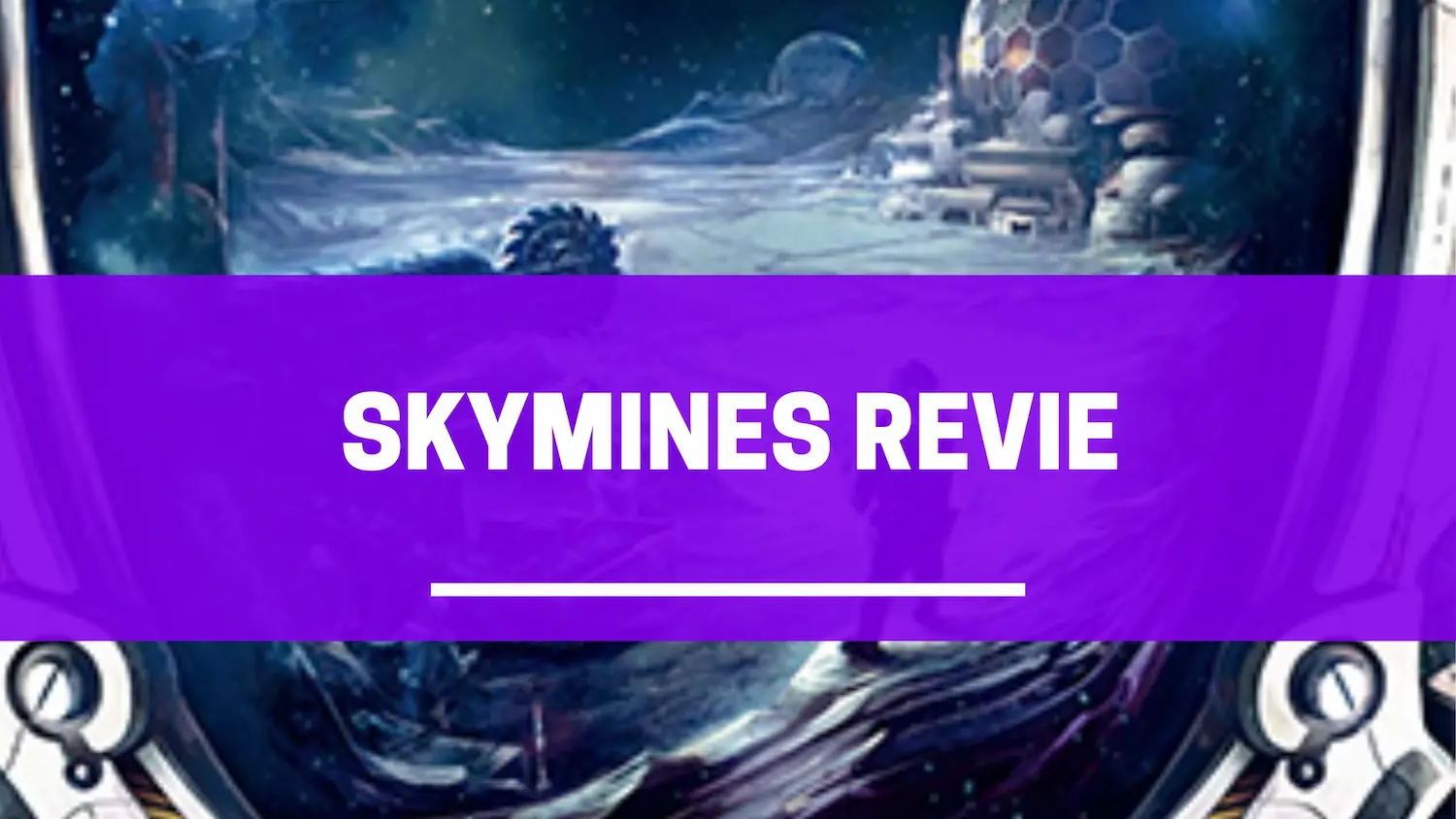| Players | Time | Age | Author |
| 1 – 4 | 75 – 150 minutes | +12 years | Alexander Pfister and Viktor Kobilke |
50 years ago, humanity began digging on the moon and asteroids, and for decades the world government kept this task under its control. But the riots of the last few years have caused the collapse of this project. Now, adventurous companies and private investors take to the skies to revive this mining network. This is how Skymines is presented to us , a game by Alexander Pfister and Viktor Kobilke, for 1 to 4 players, ages 12 and up, and games lasting 75-150 minutes.
How to play Skymines
At Skymines we represent investors who aim to obtain as many cyber loans as possible. For this we will invest resources and extend the outposts of the 4 companies present on the Moon.
A game lasts 7 rounds and after that, the player with the most cyber credits will be victorious . We will calculate our wealth by adding:
- Leftover cash at the end of games.
- The value of the shares that we own in the 4 companies.
- The last value that our helium-3 marker has exceeded.
- The last value that our load marker has exceeded.
At the beginning of the game, each player has a hand of cards that varies slightly from each other, as well as initial resources. We also start with three cards in our discards.
Each round of Skymines consists of 3 phases: Planning, Actions and Preparation of the next round.
- Planning , this phase is performed simultaneously by all players. Each player selects cards from his hand and places them face down on the available action spaces on his personal board (3 at the start of the game and we can unlock 2 more during the game). Once all the players have their cards distributed, everyone turns them over and we move on to the next phase.
- Actions , this phase is the most important of the game since all the action takes place. The cards that we prepare during the previous phase determine the actions that we have available. The player with the starting player marker begins the phase and takes a turn. Then the player to his left takes a turn and so on until the end of the phase. On our turn we have to perform one of the following actions:
Using 1 or more resource cards of the same type
With this action we can acquire a new card from the card market and/or advance the marker of one of the company meters. With the value of our resources we will pay the cost of the card that we want to acquire, maximum 1, and we take it to our hand and/or we advance as many squares in the measure that we choose as resources we generate (or those that we have left over after the purchase) .
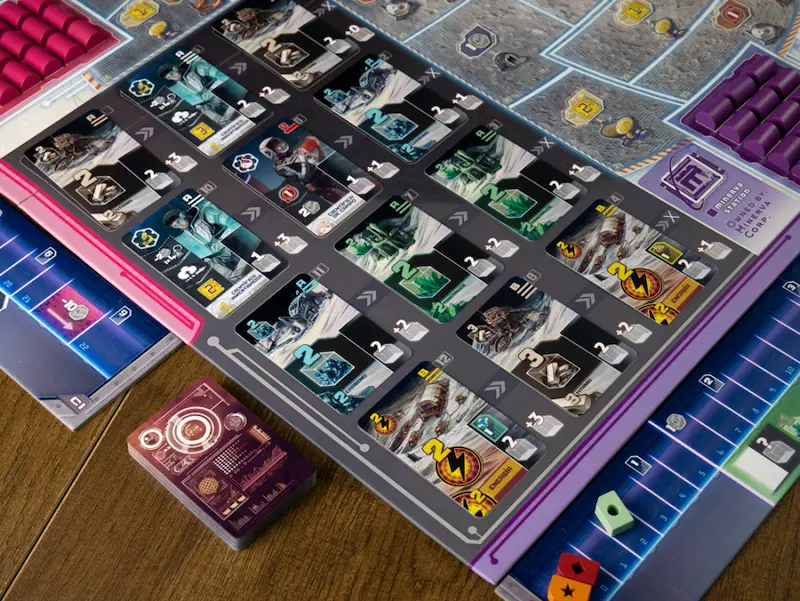
We have to pay special attention to this action, as advancing on a company meter earns us shares in that company. The cards we buy can also include a symbol of participation from one of the companies, which will be added to those obtained in the meters. The shares that we have in each company will be multiplied by their value at the end of the game.
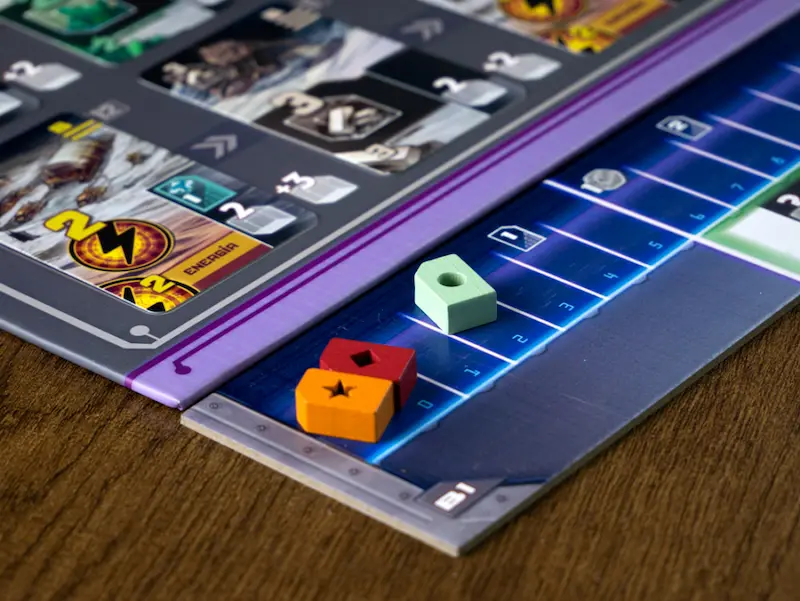
In total there are 4 companies
Use all the energy cards
With this action we can expand 1 company on the lunar surface. For them, we add up the value of our cards and we will use the result to expand a single company. Each company has 15 outposts that will occupy the sectors of the moon. After choosing which company we are going to develop, we will spend the energy points to place the outposts in the sectors adjacent to the company itself or to another position already placed.
This action is closely linked to the previous one and as we clear the stations of the companies, some cybercredit symbols will remain visible. The value of a company will be equal to the number of symbols uncovered. Do you remember the shares? Well, we will multiply the number of shares we have in a company by its value. Suppose I have 8 shares of the Minerva company and its value at the end of the game is 5. The cybercredits that Minerva will grant us is 8×5= 40.
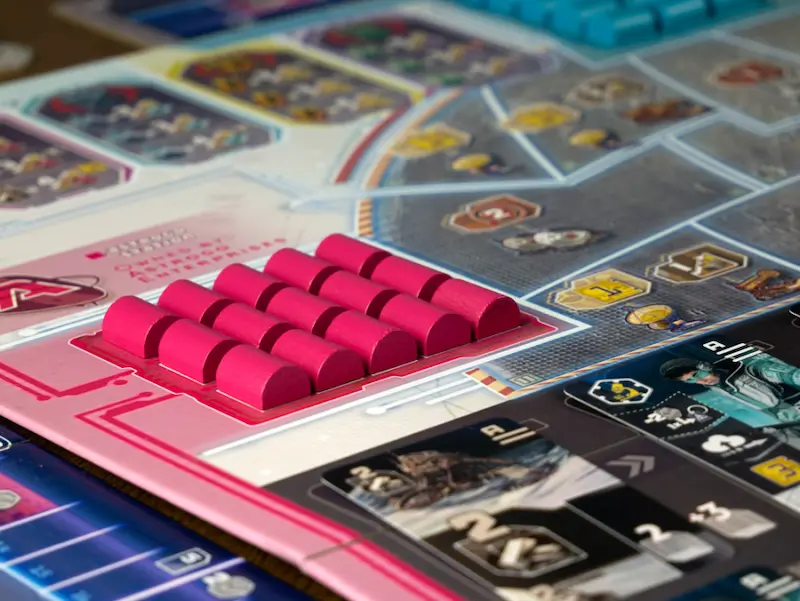
Use 1 research scientist card
With this action we can advance our charge marker. On our personal board we have a meter that represents our research plan. We will complete this meter with plan tiles, which basically present a requirement and a benefit. When playing an investigator card we will move our marker as many spaces as we want as long as we meet the tile requirements. Once we cannot or do not want to advance, we collect the benefit of the tile where we stopped. It is important to organize our meter well, since we can, with a single action, advance many squares if we have consecutively placed requirements of the same type.
After moving the marker we can buy new plan tiles to place on the meter. Without plans, our meter cannot advance and the further we go, the better, since we will obtain more cyber credits at the end of the game.
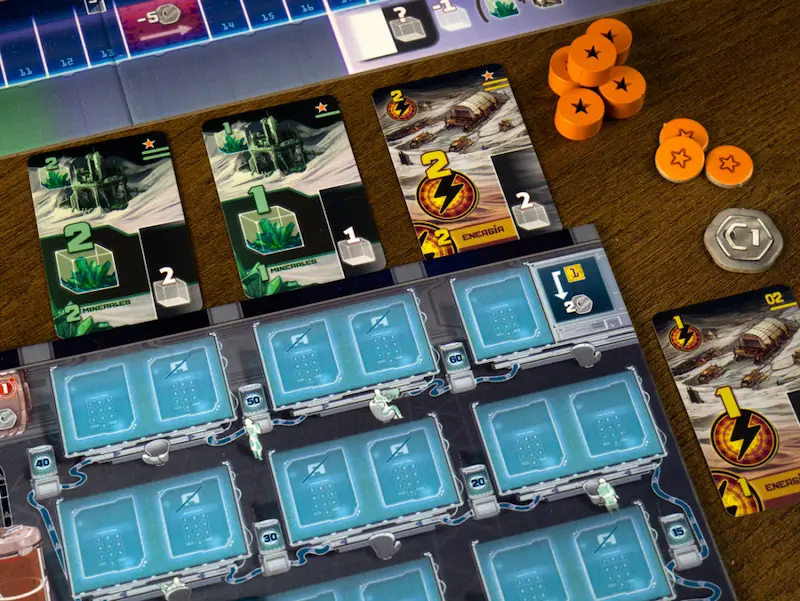
We have to fill it with tiles of plans to move forward
Using 1 field scientist card, with this action we can advance our helium-3 marker
This action is very simple, since the card itself marks how many spaces we advance. In addition, some cards give us extra advances by fulfilling certain conditions and even cyber-credits.
Place a bonus marker
With this action we can place one of our markers in the available bonus squares on the board. We have 2 or 3 markers, depending on the number of players, and we can only place them in spaces that are not already occupied by another marker. These boxes give us different benefits that will help us advance in the company markers or enhance our actions. There is also a box that allows you to get the starting player marker, which is the only way for it to rotate.
Conclude the actions phase
We will only do this action when we cannot or want to perform more actions. With this, what we will do is end our participation in the current phase.
Although it may seem like the simplest action… it is one of the most important. Just as during the preparation phase we have several action spaces, we also have the same number of discard spaces . Once we conclude the actions phase, we have to choose a single deck of discards and take it to our hand , adding these cards to the ones we already had. Once done, we have to clear our action spaces by sending these cards to a different discard space than the opposition they occupy in our actions, thus deciding how we form our discard groups. Do you see the importance?If during the game we are recovering one of the discard decks per turn, we have to be very attentive to how we group the faces in them to always have available the combinations that most interest us to maximize our game turns.
When all the players finish their action phase we move on to the next phase.
Preparation for the next round
As simple as advancing the round marker, recovering our markers and replenishing the central market for available cards.
After the action phase of round 7 the game ends and we calculate our final cyber credits. We add the amount of cash we have left over +, for each company, the result of multiplying our shares by their value + the value of our helium meter + the value of our research meter. The player with the most cyber credits will be the winner!

It’s worth it Skymine?
It certainly seemed like a real game to me. So the answer is a resounding yes.
The first thing is to tell you that you are not afraid of all the components that it brings or the appearance of its regulations, it is a much more affordable game than it seems, although not for all audiences, since it is focused on a more gamer sector . If you are looking for something familiar, this is not your game.
From here, Skymines is a true marvel, it works very well for two, three and four players, the latter being a bit more chaotic in terms of deploying companies on the lunar surface. It does not have a very high interaction, but it is enough so that the actions of the other players can disrupt your plans.
We must think very carefully how to carry out our actions for various reasons and one of the most important is discarding . As I have already said, we will only take one deck in the discard and during the game we have to try to prepare the decks very well to try to take advantage of the turns. It may be that we want to carry out a specific action and that we cannot precisely because we do not have the cards we want at hand, since they are discarded.
Another point that I really liked is how the score fluctuates. As we are releasing tokens from companies (outposts) we are showing cyber credits and if we have shares of said company then we will obtain a good score at the end of the game. But on the moon there is no space for everyone and two companies cannot coexist in the same box… so when I deploy an outpost in a space where there is already another, it returns to its initial area, covering -hopefully- cyber credits from my competitors.
Obviously we can try to get points from all the companies by getting their shares, but we cannot go to all the meters, so there will always be one where we advance much more than in others and our competitors the same. So that’s what I mean by the score fluctuating. I can have 5 discovered cyber credits and by the end of the game there are only 3 because they have taken outposts from me.
Skymines is one of those games that leaves you feeling very good when you finish playing, wanting to play another game and make the most of your turns. Highly recommended, we loved it!

